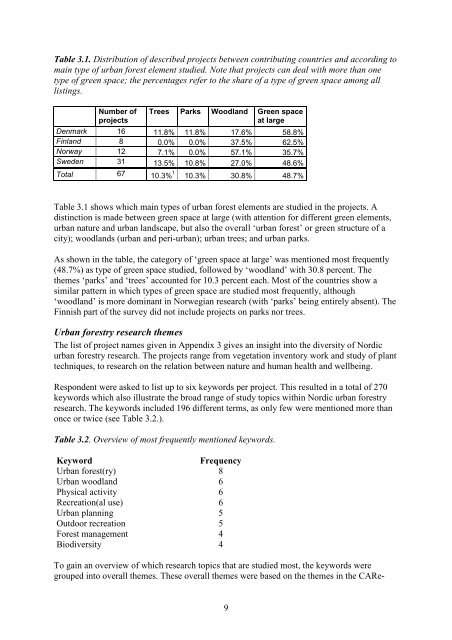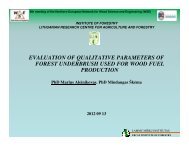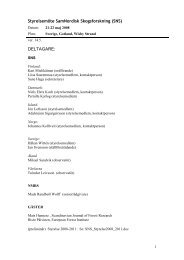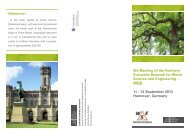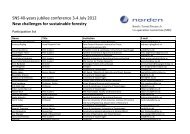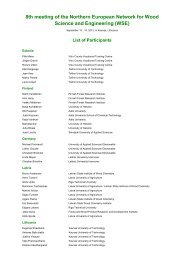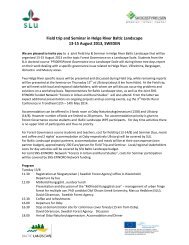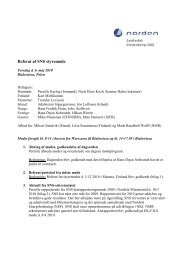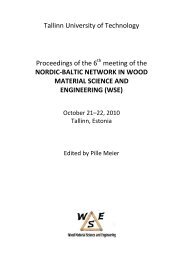Review of Urban Forestry Research in the Nordic Countries - SNS
Review of Urban Forestry Research in the Nordic Countries - SNS
Review of Urban Forestry Research in the Nordic Countries - SNS
Create successful ePaper yourself
Turn your PDF publications into a flip-book with our unique Google optimized e-Paper software.
Table 3.1. Distribution <strong>of</strong> described projects between contribut<strong>in</strong>g countries and accord<strong>in</strong>g toma<strong>in</strong> type <strong>of</strong> urban forest element studied. Note that projects can deal with more than onetype <strong>of</strong> green space; <strong>the</strong> percentages refer to <strong>the</strong> share <strong>of</strong> a type <strong>of</strong> green space among alllist<strong>in</strong>gs.Number <strong>of</strong>projectsTrees Parks Woodland Green spaceat largeDenmark 16 11.8% 11.8% 17.6% 58.8%F<strong>in</strong>land 8 0.0% 0.0% 37.5% 62.5%Norway 12 7.1% 0.0% 57.1% 35.7%Sweden 31 13.5% 10.8% 27.0% 48.6%Total 67 10.3% 1 10.3% 30.8% 48.7%Table 3.1 shows which ma<strong>in</strong> types <strong>of</strong> urban forest elements are studied <strong>in</strong> <strong>the</strong> projects. Adist<strong>in</strong>ction is made between green space at large (with attention for different green elements,urban nature and urban landscape, but also <strong>the</strong> overall ‘urban forest’ or green structure <strong>of</strong> acity); woodlands (urban and peri-urban); urban trees; and urban parks.As shown <strong>in</strong> <strong>the</strong> table, <strong>the</strong> category <strong>of</strong> ‘green space at large’ was mentioned most frequently(48.7%) as type <strong>of</strong> green space studied, followed by ‘woodland’ with 30.8 percent. The<strong>the</strong>mes ‘parks’ and ‘trees’ accounted for 10.3 percent each. Most <strong>of</strong> <strong>the</strong> countries show asimilar pattern <strong>in</strong> which types <strong>of</strong> green space are studied most frequently, although‘woodland’ is more dom<strong>in</strong>ant <strong>in</strong> Norwegian research (with ‘parks’ be<strong>in</strong>g entirely absent). TheF<strong>in</strong>nish part <strong>of</strong> <strong>the</strong> survey did not <strong>in</strong>clude projects on parks nor trees.<strong>Urban</strong> forestry research <strong>the</strong>mesThe list <strong>of</strong> project names given <strong>in</strong> Appendix 3 gives an <strong>in</strong>sight <strong>in</strong>to <strong>the</strong> diversity <strong>of</strong> <strong>Nordic</strong>urban forestry research. The projects range from vegetation <strong>in</strong>ventory work and study <strong>of</strong> planttechniques, to research on <strong>the</strong> relation between nature and human health and wellbe<strong>in</strong>g.Respondent were asked to list up to six keywords per project. This resulted <strong>in</strong> a total <strong>of</strong> 270keywords which also illustrate <strong>the</strong> broad range <strong>of</strong> study topics with<strong>in</strong> <strong>Nordic</strong> urban forestryresearch. The keywords <strong>in</strong>cluded 196 different terms, as only few were mentioned more thanonce or twice (see Table 3.2.).Table 3.2. Overview <strong>of</strong> most frequently mentioned keywords.KeywordFrequency<strong>Urban</strong> forest(ry) 8<strong>Urban</strong> woodland 6Physical activity 6Recreation(al use) 6<strong>Urban</strong> plann<strong>in</strong>g 5Outdoor recreation 5Forest management 4Biodiversity 4To ga<strong>in</strong> an overview <strong>of</strong> which research topics that are studied most, <strong>the</strong> keywords weregrouped <strong>in</strong>to overall <strong>the</strong>mes. These overall <strong>the</strong>mes were based on <strong>the</strong> <strong>the</strong>mes <strong>in</strong> <strong>the</strong> CARe-9


